
Sacred Texts Native American Plains Index Previous Next
Buy this Book at Amazon.com


The Old North Trail, by Walter McClintock, [1910], at sacred-texts.com
Reserve and haughtiness of the Bloods.—Pathetic mourning of a mother for her son.—Tragedy of Opiowan, "The Mad Indian."—Journey along the Okoan River.—Onesta and Nitana pray for a prosperous journey and my success.—Onesta teaches me two queer Blackfeet songs.—Beautiful valley of the North Piegans.—The trail along the Crow Lodge River.—Interesting Indian names for local topography.—Lookout Butte and the Indian watchers.—Camp of Brings-down-the-Sun.—His dignified and hospitable welcome.—Our attractive camp under the cottonwoods.—Indian custom of exchanging gifts.—Ideal camp of a happy and contented Indian clan.
WE remained several days in the Blood camp to rest our horses and visit Indian relatives and friends. The Bloods are a fine looking tribe, but reserved and haughty. They seem to be on the best of terms with the North Blackfeet, but are not popular with other tribes, because of their conceit and arrogance. The Piegans have a saying, "He is just like a Blood, he likes to show off." They also speak of the Bloods as "generous givers, but always seeking to get back as large a return as possible."
An incident occurred, while I was present at a Sun-dance of the Piegans, which illustrates the peculiar manners of the Bloods. It was in a large assembly of Indians, including representatives from sixteen different tribes, guests of the Piegans, who were gathered around the Sun-lodge, listening to the war stories of prominent chiefs. Unlike their white brothers, it is the custom of
[paragraph continues] Indians to always listen with respectful attention to the speeches of their leaders, without regard to their importance. But not so with a visiting band of young men from the Bloods. While the old Piegan chiefs were recounting their brave deeds in battle, the Bloods
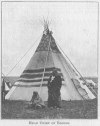
Click to enlarge
HEAD CHIEF OF BLOODS.
gave great affront and transgressed all custom and etiquette by publicly ridiculing their stories.
For my own part, I have found that the Bloods are not so approachable, and lack the cordiality and open hearted friendliness so characteristic of the Piegans.
After sunset, on our way to One Spot's lodge, we were startled by the mournful wailing of a woman, standing upon a lonely butte, overlooking the river valley.
[paragraph continues] Snake Woman told us that she was the mother of Has-many-guns-in-the-camp, mourning over his death. The sad news had just come, that he had died in the camp of the North Blackfeet. While absent on a long journey, he had heard that his wife had left him for another. Has-many-guns mourned so deeply over the loss of
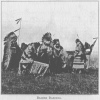
Click to enlarge
BLOODS DANCING.
his wife, that he refused to eat and finally died from starvation.
The similarity of the cause of this pathetic incident,—the infidelity of a wife,—reminds me of a much more tragical event, which happened in the winter of 1896, during my visit among the Piegans.
Opiowan, a Blood Indian, living just across the border in Alberta, killed his rival, who had stolen his wife's
affections. For many weeks he kept the Indian families on both sides of "the line" at the highest pitch of excitement and alarm because of his sudden attacks and cold blooded murders. He proved himself more than a match for the Canadian Mounted Police in his Indian cunning and resourcefulness in evading arrest.
This Opiowan tragedy illustrates the capabilities of a single Indian for cunning, ferocity and physical endurance,

Click to enlarge
BLOOD CUSTOM OF PILING WINTER WOOD.
when fired by revenge for wrongs suffered. When one such was multiplied into a band, or tribe united for revenge, as in the cases of the Sioux, Apaches and Nez-Perces, it meant a bloody war against the whites. War meant extermination for the Indian, for it developed among the whites that bitter animosity which was universal along the frontier and still finds expression in that laconic but barbarous saying, "The only good Indian is a dead Indian."
Opiowan was reported as frequenting so many localities
and as moving about with such incredible swiftness, while murdering indiscriminately, that all, whether in the mountains, or on the plains, were in dread of a surprise by him. The Piegan women spoke of him in great fear as the "Mad Indian," while the mere mention of his name filled the children with terror. When I asked Snake Woman for the Blood account, she related the following thrilling story of vengeance under the "unwritten law."
"Opiowan once lived at peace with all our tribe. He was known as an industrious man, living contentedly in a lodge with his two wives, his mother and his only child, a boy of eight. A young man named Natomina, a former lover of Pretty Wolverine, his favourite wife, began coming to the lodge. When he became so deeply enamoured that his attentions were the talk of the tribe, Opiowan warned him to desist. One day Opiowan prepared for a journey, as if he would be absent for several days. He rode off over a ridge, but, instead of going farther, lay in ambush to watch his lodge. When he saw Natomina and Pretty Wolverine cross the meadow together, he quietly returned and with drawn knife came unexpectedly upon the guilty lovers. He mutilated and killed Natomina, but spared his wife. Having ordered her to return quietly to the lodge, he continued his journey. When the Mounted Police discovered Natomina's dead body, some days later, they carried it through the camp, vainly endeavouring to find some trace of the murderer. When Opiowan returned from his journey, he heard the people talking about the mysterious murder. At night the face of Natomina
was always before him, so that he was unable to sleep. He dreaded hearing a rider enter the camp, lest it might be one of the Mounted Police coming to arrest him. He became morose and gloomy and shunned his friends, imagining that all had turned against him. He thought he must be going mad and desired to live no longer. Resolved to die the death of a brave, he vowed he would kill as many people as he could, both Indian and white. Passing the store at night, and seeing the trader standing near a window, he raised his rifle and fired. He saw the trader fall forward upon his face and then fled in the darkness. Returning to his lodge, he told his wives that he had shot a white man, and he must hide in the mountains. The lodge was quickly taken down, and their belongings packed upon a travois. Opiowan put on his war charm and, painting his face, chanted a war song. They entered the Rocky Mountains, camping in a small glade, where their lodge was hidden by the trees. When the Mounted Police heard of Opiowan's escape, they knew he must be the murderer and followed his trail. But Opiowan, watching from a neighbouring cliff, saw them coming. Knowing they would enter the glade from below, he left his mother and son in the lodge and with his wives circled through the forest. The police tied their horses at the lower end of the glade and advanced on foot. They shot into the lodge, but the boy and woman lay flat and were not hit. Opiowan then came quickly from the forest and made off with their horses. The police captured the old mother and the boy and withdrew, after destroying the lodge, but Opiowan, with his two wives, escaped by going northward along the Rockies. When they came to the country of the North Piegans, they entered the Porcupine Mountains and hid
themselves in the forest. Whenever they ran short of food, or ammunition, Opiowan stole down at night into an Indian camp, shooting anyone who would oppose his demands. One day he rode boldly through the main street of a small town (Cardston), and shot one of the police. They followed him many miles, but were unable to capture him. On a big flat beyond the Kootenai River, Opiowan killed another of his pursuers, whose horse had outrun the others, and seizing the policeman's rifle and ammunition, escaped into the forest. The autumn passed and winter came on with intense cold and deep snow, but no one could 'find his hiding place. One night, in a heavy snow storm, Opiowan left the camp of Brings-down-the-Sun, where he had suddenly appeared to demand food and ammunition. He lost his way and was followed by the police, but again managed to elude his pursuers. At last, fearing that his wives might desert him while absent on foraging expeditions, he hobbled them, tying their hands and feet, but leaving them separated from each other. Managing to free themselves, they made their way down the mountains by night and came into the Blood camp on the plains, where they were arrested. Opiowan, deserted by his wives, without food and suffering from the intense cold, was finally driven from the mountains by starvation. He came one night to the lodge of his brother Sixepe, who kept him in hiding. The information was carried to the police, who surrounded the camp, and ordered them to give up the outlaw. Our chiefs in their alarm finally prevailed upon Sixepe to betray his brother into the hands of the police. As he lay tied hand and foot, Opiowan warned his brother that he would die first. Within four days Sixepe suddenly sickened and died. Opiowan also died soon after, killing
himself by piercing the arteries of both wrists with a sharp awl."
We left the Blood camp soon after sunrise, riding along the Okoan River, and through groves of large
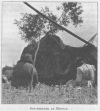
Click to enlarge
SUN-SHELTER AT MIDDAY.
cottonwoods. After fording the river, we turned towards the mountains and the country of the North Piegans. Heavy clouds covered the plain, completely hiding the rising sun. But the snow-clad summits of the Rockies in the west, glowed in the rays that shone above the clouds. We followed an old Indian trail known to Kionama and Onesta, a short cut, that took us across a broad plain. When we entered the hill
country beyond, the clouds disappeared and the hot sun again shone in a clear sky. My thermometer registered 98 degrees in the shade and 130 degrees in the sun. We rested our horses at midday near a small lake. The women erected a shelter from the sun by throwing canvas over a wagon pole, supported on a tripod. The sides were then raised, allowing the breeze to blow through.
In the early afternoon clouds gathered over the Rocky Mountains. Electrical storms appeared in all directions and the air gradually became cooler. While slowly winding our way among the high hills, I heard Onesta and Nitana chanting a religious song. I quietly rode behind them and, after becoming thoroughly familiar with the air, joined in the chant. They explained that it was an ancient custom, while travelling towards a strange country, to chant and offer prayers to the Sun for a prosperous journey and safe return. Onesta said, "On this occasion, we have been praying also, that you may be successful in securing the information you desire from the North Piegans. I intend giving the Sup-weyo-kinni (Crow Beaver) ceremonial in their camp and I will teach you some of the chants, so that you can help us in the singing." Nitana expressed her uneasiness, lest some misfortune might overtake us, because one of the medicine sticks of the Crow Beaver Bundle had been broken while in the Blood camp.
Onesta taught me the Worm song, which the Blackfeet use to make worms dance. When we came to a wild rose bush covered with cobwebs enclosing small worms (Tent Caterpillars), he directed me to stand near and sing, "Kom-i-os-ché! Kom-i-os-ché!" (Worms! Worms!), beating time by clapping my hands. To my surprise, the worms, which had been perfectly still, began to move
as if slowly waking up. They soon became more active, until all stood erect and swayed their heads to and fro. Onesta sang another song, with which, he said, he could make a sand-piper dance, by clapping his hands and singing, "Ék-si-sa-que! Ék-si-sa-que!" (Meat! Meat!)
He called my attention to the swallows hovering over the horses to secure hairs for their nests, and also to the grasshoppers flying high in the air "to colour their wings." Grasshoppers’ wings are said to be without colour, until they fly into the sunlight, which turns them red, yellow and black.
When we finally gained the summit of the ridge, we looked down upon the broad valley of the North Piegans, through which flowed a river, bordered with huge cottonwood trees. Towards the north were the Porcupine Mountains covered with dark forests of pine, and westward were the snow-capped summits of the Rockies. While descending towards the valley, we met several young men of the North Piegans, guarding their tribal herds of cattle and horses. They guided us towards the camp of Brings-down-the-Sun. One of them, whom I afterwards discovered was the son of Crow Eagle, the head chief, rode with me. He pointed out an enormous solitary rock upon the prairie, and said: "Many years ago a huge grizzly lived in a cave beneath that rock. Around it grow different varieties of berry bushes from seeds carried there by the bear." The Porcupine Mountains are so named, because the ridges bristle so thickly with tall trees that they resemble a porcupine's back. The river in the valley before us was called Old Man's River by the white men, but Crow Lodge by the Indians, the vision for the Crow Lodge having been received in former days near its source. The high mountain, with a broad slide shining like a huge glacier, is called Turtle
[paragraph continues] Mountain by the whites, but is named Lodge Lining by the Indians, because its slopes are uniform and regular, resembling the inside lining of a lodge.
Having reached the river, Crow Eagle's son invited us to his tipi. But, when Onesta explained that we must go direct to the camp of Brings-down-the-Sun, he
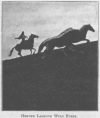
Click to enlarge
HERDER LASSOING WILD HORSE.
pointed out to us a distant bend in the Crow Lodge River, saying that we would find Natosin Nepe-e (Brings-down-the-Sun) there among the big trees on the north bank.
After the young men had left us, I observed a single horseman appear upon the summit of a distant ridge and remain to watch our course, that we might not go astray. The trail led down a steep hill and into the
valley. A wolf standing motionless, watched us from the head of a small ravine. The colour of his coat was so like the grass and willows surrounding him that he had an excellent colour protection. The deep shade of the big trees and luxuriant vegetation of the river valley were most refreshing, after the fierce sunlight and heat of the plains. The meadows were bright with a
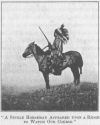
Click to enlarge
“A SINGLE HORSEMAN APPEARED UPON A RIDGE TO WATCH OUR COURSE.”
beautiful pink flower called Manekape (young man) by the Blackfeet, but known by botanists as Horse Mint, or Monarda scabra. The trail ran sometimes close to the broad, swift river, now through meadows of grass and flowers and now among the cottonwoods. Passing through an opening among the trees, I saw, in the distance, a group of Indians, wrapped in blankets, standing on the edge of a high cut-bank overlooking the valley. They were watching our approach with evident
interest. Onesta explained to me that it was a "Lookout Butte" for the camp of Brings-down-the-Sun. From its summit, not only the river valley, but also the surrounding plains could be viewed for a long distance. As we drew nearer, I discovered that the watchers were women. One with a baby on her back, her long black hair flying in the wind, and her figure distinctly outlined against the evening sky, was standing surrounded by children. Nitana recognised her as Long Hair, favourite daughter of Brings-down-the-Sun. As we approached the edge of the clearing, a group of white lodges among the trees came into view. It was the camp of the noted medicine man, with his children, grandchildren and great-grandchildren. In front of a lodge, beneath a huge cottonwood, and close to where the trail again entered the trees, a tall figure, with a blanket wrapped closely around him, stood gazing intently at us. When he recognised Onesta, he hailed us and said: "My children, I will be glad to have you pitch your lodges close to mine, under the big trees on the other side of the trail." I rode nearer to observe him more closely. He was an elderly man with clean-cut Indian features. His hair was grey and the deep lines in his face indicated a strong character, burdened with care and responsibility. With hand upraised and head thrown back, he had the air of one accustomed to command. Pointing to the meadow, he continued, "However, if you wish, you can camp in the open at the edge of the cottonwoods. Sometimes heavy wind-storms tear branches from the trees, and if your lodges were beneath they might injure you. On the north side of the clearing you will find a spring, where the water is cold and good to drink. It will be better for you to take your horses upon the hills, where they
can feed upon the abundant bunch grass." With these words the chief withdrew into his lodge.
The cool shade of the woods proved such an attraction that we promptly selected the spot beneath the big trees pointed out by Brings-down-the-Sun. While our lodges were being pitched, Sis-tse (Bird), wife of the chief, with her daughters and daughters-in-law, arrived, bearing many presents. This exchange of gifts among the women was always an interesting performance. They often gave many objects, that were highly prized by themselves, although they might seem of little value to white people. For instance, Nitana received on this occasion an old tea-pot, a wash tub and board, a small bag of beans, two plates, two cups, a copper kettle and a butcher knife. In return, she gave two blankets, two pairs of moccasins, paints dug by herself on Birch Creek, and a few trinkets. Bird brought an invitation from Brings-down-the-Sun, for Onesta, Kionama and their friend, the white man, to eat with him at sunset. When we walked down the wooded trail towards the tipis of the chief and his son Running Wolf, standing close together at the end of a grove of huge cottonwoods, we came upon an ideal camp and the most peaceful and charming picture of a happy and contented Indian family it has ever been my good fortune to see. A large outside fire sent a shower of golden sparks into the air. It lighted up the white tipis with their clusters of tapering poles, and tops deeply browned by smoke, and brought them into sharp contrast with the dark trunks and green branches of the big cottonwood trees. Grouped around the fire, and dressed in brightly coloured Indian clothes, were women and young girls engaged in animated conversation, while cooking, making clothes and moccasins and playing Indian games.
[paragraph continues] To one side a little baby hammock, swung between two saplings, was rocked by a mother singing a Blackfeet slumber song. When we stepped into the circle of bright firelight, this peaceful scene was rudely disturbed by a dog dashing at us, with flattened ears and snarling fiercely. A squaw shouted, "Puksiput! kokun! Kopsksis-e!" (Come back here! you pup! Swell Nose!), but the damage was done. The group of young girls, warned of the approach of the strange white man, fled precipitately into the woods, and the charming circle was quickly broken.